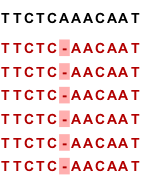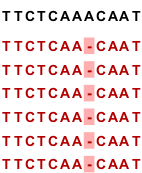Gap placement
In the case of insertions or deletions in homopolymeric or repetitive regions, the precise placement of the insertion or deletion cannot be determined from the data. An example is shown in figure 31.20.

Figure 25.8: Three A's in the reference (top) have been replaced by two A's in the reads (shown in red). The gap is placed towards the 5' end, but could have been placed towards the 3' end with an equally good mapping score for the read.
In this example, three A's in the reference (top) have been replaced by two A's in the reads (shown in red). The gap is placed towards the 5' end (left side), but could have been placed towards the 3' end with an equally good mapping score for the read as shown in figure 31.21.

Figure 25.9: Three A's in the reference (top) have been replaced by two A's in the reads (shown in red). The gap is placed towards the 3' end, but could have been placed towards the 5' end with an equally good mapping score for the read.
Since either way of placing the gap is arbitrary, the goal of the mapper is to place the gaps consistently at the same side for all reads.
Many insertions and deletions in homopolymeric or repetitive regions reported in the 1000 Genomes public database have been identified based on mappings done with tools like BWA and Bowtie, that place insertions or deletions at the left side of a homopolymeric tract. Thus, to help facilitate the comparison of variant results with such public resource, the Map Reads to Reference tool will place insertions or deletions in homopolymeric tracts at the left hand side. However, when comparing to dbsnp variant annotations, it is better to shift variants according to the 3' rule of HGVS. This can be done using the option "Move variants from VCF location to HGVS location" of the Amino Acids Changes tool.
This is a change to earlier versions of the CLC Genomics Workbench (version 6.0.5 and earlier) where the read mapper placed insertions and deletions in homopolymeric tracts at the right hand side of the homopolymer, as viewed in the Workbench.
For users of the COSMIC database or other clinical databases following the recommendations from the Human Genome Variation Society (HGVS)
The Human Genome Variation Society (HGVS) recommendations, which pertain to variants within genes, state that for insertions and deletions in homopolymeric or repetitive regions, the most 3' position (corresponding to the strand of the gene) possible should be arbitrarily assigned as the site of change (see http://varnomen.hgvs.org/). Resources such as COSMIC adhere to these recommendations. In this case, placement to the farthest possible left hand position, as viewed in the CLC Genomics Workbench, of insertions or deletions in repetitive or homopolymeric tracts, has a different effect, depending on whether the gene involved is on the positive or negative strand of the reference. Such variants located within genes on the negative strand can be compared with the COSMIC database, while those within genes lying on the positive strand cannot be, as the positions relative to the reference will be different in this case.
